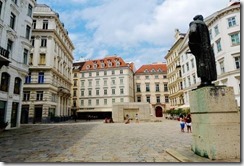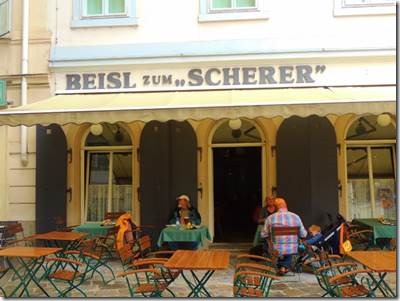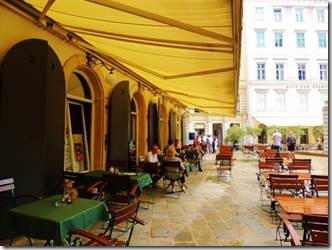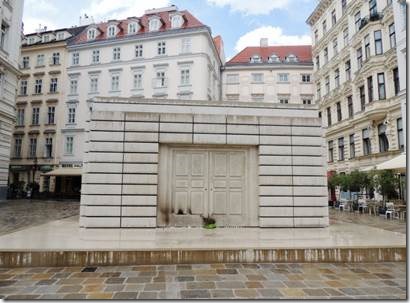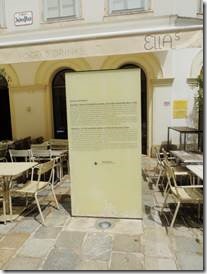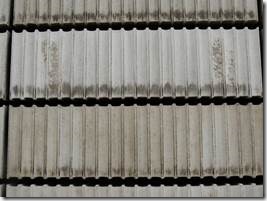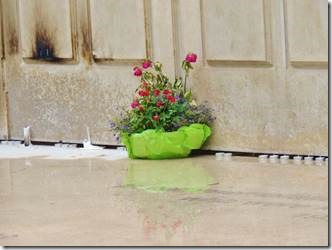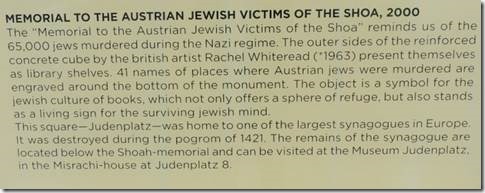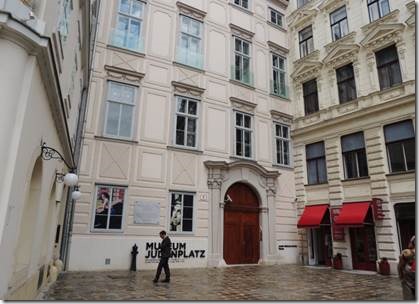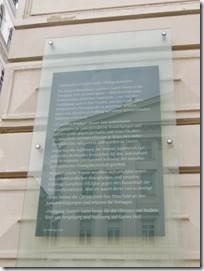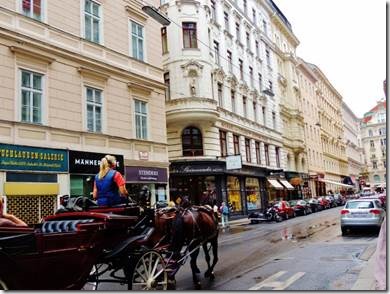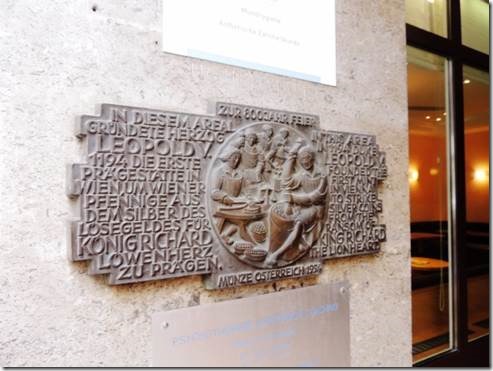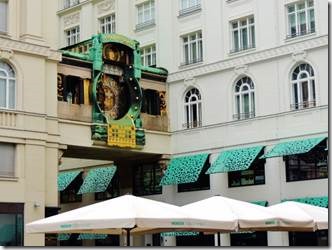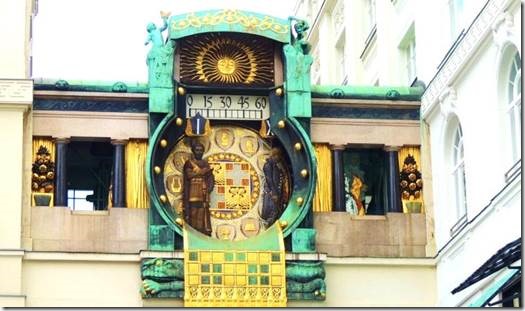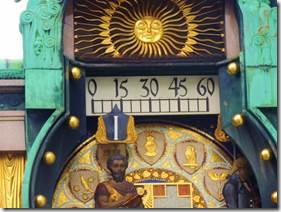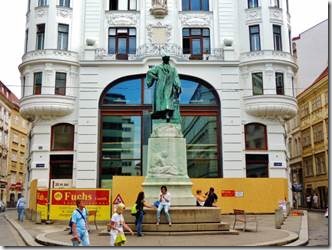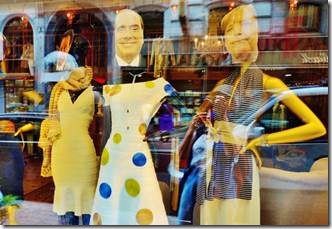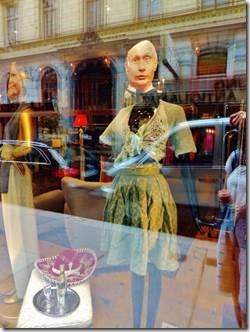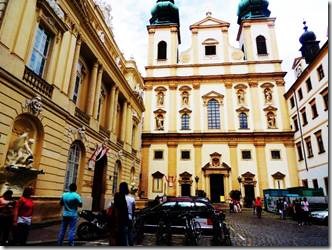The other side of the one Slovakian lock..and the biggest of the trip
Dobré Ráno,
Last Friday afternoon Randal went with me on a walking tour called “Jewish Vienna in Leopoldstadt.” We chose that particular tour because it was the one Jewish tour available the days we would be in Vienna.
I always think of myself as Jewish, (which of course I am) but when our guide was explaining the connection between Hebrew and Yiddish and Austrian/German, I felt a real disconnect. I never learned Yiddish and my Hebrew is mostly forgotten. I felt as if I’d missed out somehow.
So much of Leopoldstadt from the turn of the century until the late 30s is no longer there forcing you to “imagine” what life had been like. Many of the buildings had been destroyed or Ayranized during the Nazi occupation. The area we visited, Leopoldstadt was not far from the huge train station so the area was heavily bombed by the Allies.
http://global-writes.com/ is a very readable site about Jews in Vienna before, after and now. And pre-war Jewish history was very much a part of Viennese history and culture in the arts and sciences and culture.
Ru
|
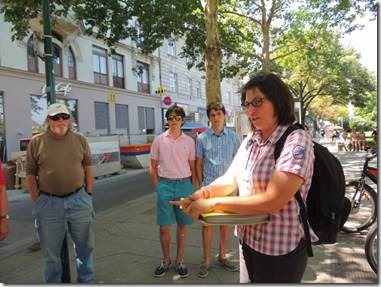
A walk through the vanished world of Vienna’s Jewish Quarter between the Danube and the Canal. Leopoldstadt, Vienna’s second district, was once a hub of Jewish life. Some of the town’s finest synagogues were to be found there, also a wide array of Jewish shops, clubs, theatres and coffeehouses, and the splendid Grain Exchange, focal point of Jewish commercial interests. Leopoldstadt was also a central-European stronghold of Zionism and Chassidism. Sigmund Freud spent his youth there, composers Arnold Schönberg and Oscar Strauss were born there. This Jewish world was brutally destroyed in the Shoah, but new Jewish life has come back. On this tour we also follow the "Path of Remembrance" commemorating Jewish victims of the Nazi terror. http://www.viennawalks.com/indexe.php?page=start
Regardless of its origin, ghettos were a significant part of medieval Jewish life. But as Ravid points out, “All ghettos were Jewish quarters, but not all Jewish quarters were ghettos.” Jews sometimes voluntarily agreed to live in separate sectors, but often it was not their choice. http://www.momentmag.com/jewish-word-ghetto/ is an interesting discussion of the word ghetto which came up during our tour. Leopoldstadt was a “Jewish quarter” rather than a ghetto.
Barbara Timmermann was warm, friendly, knowledgeable and truly interested in each of our stories. She was helping several of the women on our tour find information about their families. Two of the women were researching parents and grandparents who had lived in Vienna. Barbara speaks English, German, Spanish and probably others too. People who take the time and make the effort to learn other languages are wonderful! She seems to see Vienna as a very livable city attracting many educated Jews connected with their work; many from America.
“Just as enthusiastic and lively as her mother is Barbara, who joined VIENNAWALKS & TALKS as a junior partner in 2002. It is not surprising that her interest in other cultures, her work experience abroad and her love of both foreign languages and adventure qualify her quite naturally for a career in guiding and tourism. A graduate of a Vienna College of Tourism she is a brilliant organizer when it comes to setting up sightseeing programmes for large parties, but her knowledge, thoughtfulness, and most of all, her flexibility are also greatly appreciated by small parties or individual travellers. Among her many special themes are Jewish Vienna, the world of the Habsburgs, and post-World War II history. With her eye for the eccentric and her sense of humour she easily catches the hearts of her clients, and it is hardly surprising that she is very much in demand. When she is not guiding, she is in charge of the company’s books, indulges in diving, skippering through the Mediterranean, or improving her command of the Spanish language.” http://www.viennawalks.com/indexe.php?page=wir
|
|
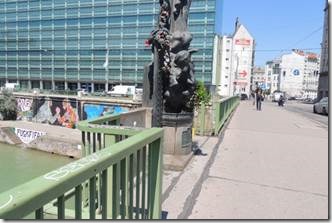
Crossing the canal to the area of Leopoldstadt.
|
|
http://www.hakoah.at/en/textedetail.asp?Block=1&ID=150
In Vienna, on the night of Saturday, November 7, the Sports Club Hakoah, also known as Hakoah Vienna, held a gala ball to celebrate its 100th anniversary. The evening’s entertainment included a bare-chested acrobat whose midair gyrations, on a swath of purple cloth hung from the ceiling, suggested both the precarious nature of Jews in Vienna and the skills used to pull off this event.Fittingly, the ball was held at Hakoah’s new Karl Haber Sports & Recreation Center. The center’s completion last year, funded by the Austrian government as part of the 2001 “Washington Agreement,” figures in the ongoing reckoning between Jews and non-Jews in Austria today. Steps away from the sports center is a new secondary school, Zwi Perez Chajes Schule, which offers Hebrew and Judaic studies in addition to a standard Austrian curriculum. Also within the complex is a nearly finished building with assisted-living units for the elderly. All three organizations are open to non-Jews.
http://forward.com/
http://forward.com talks about the history of Hakoah, the Jewish Austrian Olympic athletes and how Austrian Jews feel today.
|
|
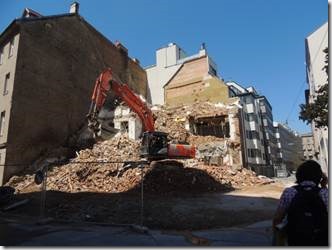
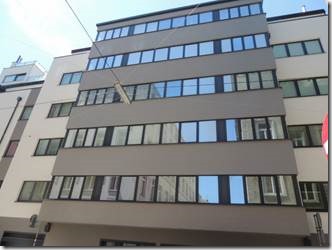
This blah looking building has apartments that sell in the millions of euros. Location, location, location.
|
|
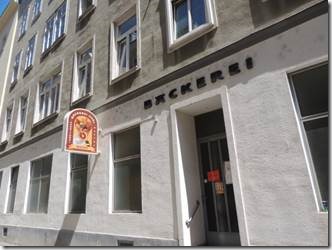
A kosher bakery especially popular on Sunday when “non-kosher” bakeries are closed.
|
|
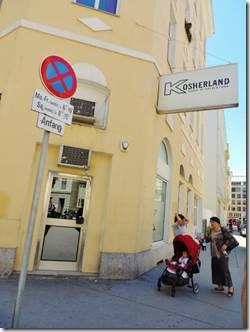
A kosher grocery store
|
|
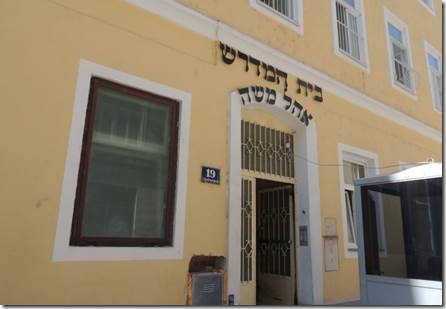
I believe there was a small synagogues in this building.
|
|
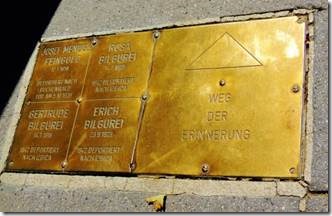
“For the many people who were murdered whom nobody remembers.”
http://www.steinedererinnerung.net/
Remembrance Stones similar to the German Stumbling Stones.
The project began in May 2005 when Elisabeth Ben David-Hindler got a request from her Israeli uncle, who wanted to put a commemoration plaque on his parents’ house in the 9th District, where about one third of the population was Jewish before WWII. Elisabeth’s parents managed to escape to Britain, but her grandparents stayed in Vienna and were deported to the concentration camp in 1941 and 1942. And she could never understand why there was nothing in the 2nd District, where she lived, to commemorate the Jews who had lived there. So she approached city authorities, and in two months was able to place the first of 84 plaques on Volkertplatz, near the Augarten in the 2nd district. …….
This is what the Path of Commemoration is all about, a path of stones laid by the Stones-of-Remembrance Society for those who have no relatives left to remember them and to mourn for them. Others are laid by the surviving relatives, who have come back to honor them from émigré communities all over the world.
http://www.viennareview.net/news/special-report/path-of-memory
|
|
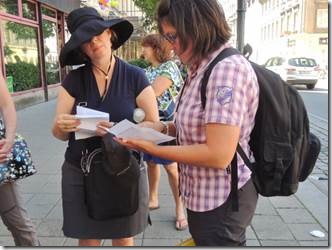
This woman from New Jersey’s father lived in the section that Barbara’s mother-in-law lives in now. Barbara would help her more through email.
|
|
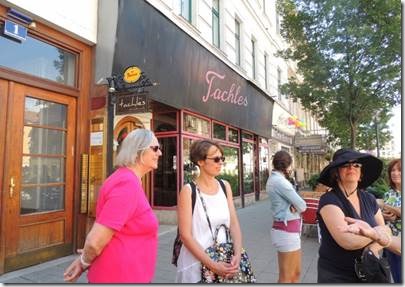
Tachles Cafe
Barbara said many Yiddish words were found in Austrian/German and showing up more once again.
tachles – (Yiddish) Literally derived from the word “purpose”. It means, “bottom line, concrete, tangible”. Example: “That’s enough talk, tell me tachles…” When someone says “Let’s talk tachles”, you know they mean business. http://www.culturalsavvy.com/expressions_Hebrew.htm
|
|
Leopoldstadt now is a sought after address because it’s near the underground, the old town, and it’s being renovated.
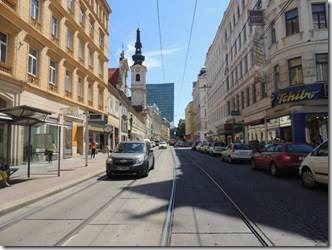
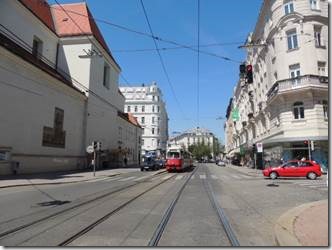
|
|
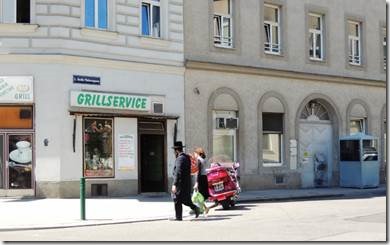
I believe that through the curved entrance is a rabbinical seminary. Hence the guard house though I don’t know if they are always staffed.
|
|
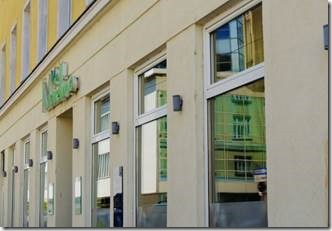
A kosher Italian restaurant with two kitchens so they can serve both dairy and meat dishes. Wonder if the tables are separated as they were in Ashdod in Israel.
|
|
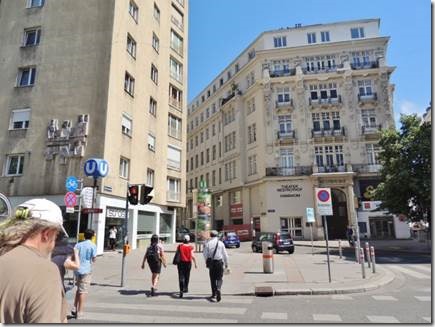
A Jewish cultural gem: the Nestroyof Jewish Theatre in Vienna
“Now, after more than half a century of neglect, the theater has been discovered virtually intact within the Nestroyhof building. However, it remains closed, blanketed in dust and lost to public view. The theater is on the first floor of a privately owned apartment building, which is to be granted landmark status soon. The original building was designed at the beginning of the 20th century by Oskar Marmorek, a well-known Viennese Art Nouveau architect and Zionist Jew. While Austria’s current landmark-protection laws forbid the owners from destroying architectural details, it would not proscribe what the theater space could be used for or require the owners to foot the bill for restorations……..
But Vienna’s vibrant Jewish Broadway became a distant memory as the theater troupes and their audiences fled abroad or died in the Holocaust. Many of the buildings housing the theaters were damaged during the war, including the Nestroyhof, which was restored in 1957. Others were later torn down. Of the eight Jewish theaters that existed before 1938, only the Nestroyhof remains.” http://www.jewish-theatre.com/
|
|
The Leopoldstädter Tempel was the largest synagogue of Vienna, in the district (Bezirk) of Leopoldstadt. It was also known as the Israelitische Bethaus in der Wiener Vorstadt Leopoldstadt. It was built in 1858 in a Moorish Revival style by the architect Ludwig Förster. The tripartite facade of the Leopoldstädter with its tall central section flanked by lower wings on each side became the model for numerous Moorish Revival synagogues, including the Zagreb Synagogue, the Spanish Synagogue in Prague, the Tempel Synagogue in Kraków and Templul Coral in Bucharest. It was destroyed during the Reichskristallnacht on November 10, 1938. A memorial plaque on the site reads in German (and Hebrew): "Hier befand sich der Leopoldstädter Tempel, der im Jahre 1858 nach Plänen von Architekt Leopold Förster im maurischen Stil errichtet und am 10. November 1938 in der sogenannten "Reichskristallnacht" von den nationalsozialistischen Barbaren bis auf die Grundmauern zerstört wurde. -Israelitische Kultusgemeinde Wien" (Here stood the Leopoldstädter Tempel, built in 1858 in the moorish style according the plans of architect Leopold Förster, all but the foundation of which was completely destroyed by National Socialist barbarians on the so-called "Night of Broken Glass", on 10 November 1938).
http://en.wikipedia.org/wiki/Leopoldst%C3%A4dter_Tempel
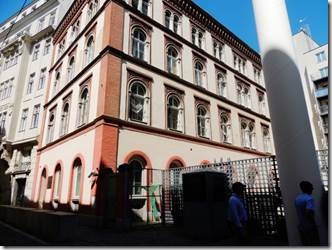
The part of the building to the left in the photo is all that remains.
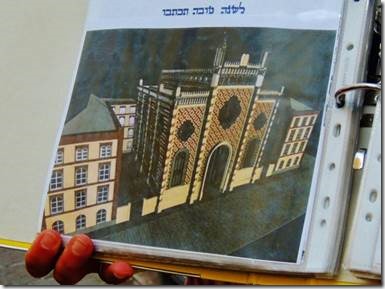
A photo of the synagogue
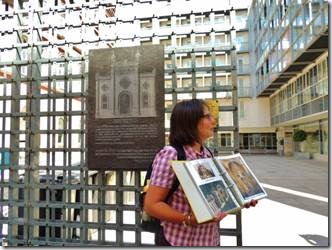
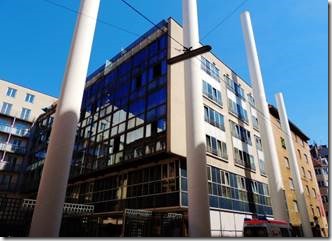
The pillars were erected by the Viennese government to illustrate the size of the original structure.
|
|
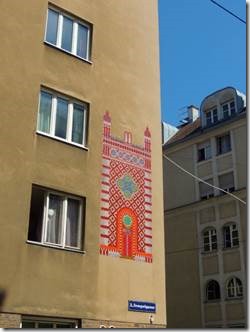
Further along Templestrasse is this colorful mosaic of the synagogue’s façade.
|
|
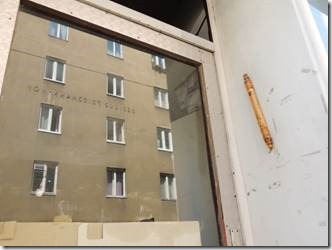
I noticed this Mezuzah on a doorway
|
|
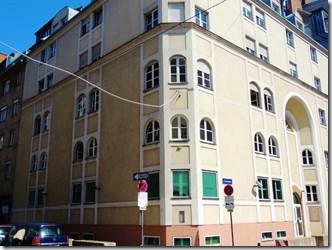
For some reason green windows indicate part of the building is used as a synagogue.
|
|
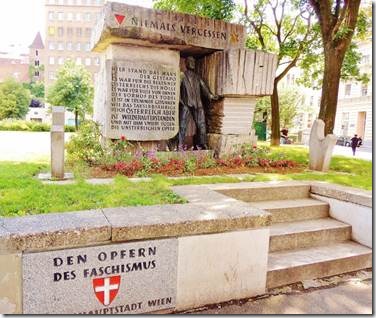
Since 1951, a memorial stone on the site of the former Gestapo headquarters commemorates those who were imprisoned here. In 1985, the City of Vienna set up an official monument here, this time dedicated to all victims of National Socialist tyranny.
The Federation of Concentration Camp Survivors held a meeting on 11 April 1951 where they erected and unveiled a memorial stone for the Gestapo victims that had been designed by the Federation. The memorial stone was erected without official authorization and was later taken care of by the City of Vienna. A new memorial for the victims of the Nazi tyranny was unveiled by the "Austrian federations of concentration camp survivors and resistance fighters" instead of the memorial stone. A bronze sculpture and a block of granite from Mauthausen now symbolise the fate of the victims.
https://www.wien.gv.at/
|
Jewish Life Today
Although the focal point is the synagogue in Seitenstettengasse, Jewish people today live all over the city. The second district, Leopoldstadt, has a particularly high Jewish population. There are also numerous Jewish institutions here, for instance the new IKG campus, the Lauder Chabad Campus, the Jewish Vocational Education Center, prayer rooms, ritual baths and other religious educational institutions, and a Hakoah sports ground in the Prater which is close to the Zwi Perez Chajes school and the Maimonides Zentrum. The Zwi Perez Chajes school has a kindergarten, elementary school and high school (www.zpc.at). The Maimonides centre was created for older people, and combines an outpatient’ clinic, care facility and day center for senior citizens (www.maimonides.at).
In the second district you will also find Jewish shops, kosher supermarkets, butchers, bakers, restaurants, snack bars and, in the area around Tempelgasse, the Sephardic Center and Synagogue. The site that until 1938 contained the Leopoldstadt temple is now home to the ESRA psychosocial institution (www.esra.at) for survivors of Nazi persecution and their descendants, There is also a Jewish Institute for Adult Education (Volkshochschule) at Praterstern which also gives non-Jews the opportunity to learn more about Judaism in courses on Yiddish, kosher cookery, Israeli folk dancing, Klezmer music and religious issues. Further sources of information are the Jewish newspapers and magazines which are published alongside the official voice of the Jewish Community “Die Gemeinde”. They include “Wina” “Das jüdische Echo. Europäisches Forum für Kultur und Politik”, “NU”, “Illustrierte Neue Welt”, “David” and “Atid”.
Over the past 300 years, the Leopoldstadt district has been home to the most concentrated settlement of Jews in Vienna. It was also the location of the so-called Mazzes-Insel (“Matzoh Island”), where poor Jewish families lived, often in close quarters. The settlement dates back to the seventeenth century, when the so-called ghetto in the Unterer Werd could be found in today’s Carmelite Quarter; this neighborhood was destroyed at the end of the seventeenth century during the second major expulsion of Jews during the reign of Emperor Leopold, and a church was erected on the foundations of the synagogue. Since then, this city district has been known as Leopoldstadt. A small part of the Leopoldstadt Temple (today ESRA, Tempelgasse 5, 1020 Vienna) has been preserved.
However, this expulsion did not prevent a new settlement by Jews in the city only a few decades later – this part of the city once again became the focus of Jewish settlers. The new Lauder Chabad Campus school center was designed by Adolf Krischanitz and also houses a prayer room. Since 2008 Zwi Perez Chajes School has been re-sited to the new Campus of the Vienna Jewish Community (IKG) where the Hakoah sports ground also is. The new IKG Campus in Simon-Wiesenthal-Gasse behind the Ernst-Happel Stadium features not only educational and sports facilities, but also a youth center and a home for the elderly. The latest information can be found on the IKG website (www.ikg-wien.at). www.vienna.info

